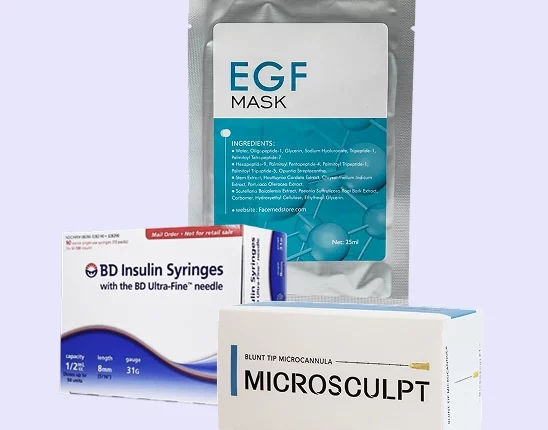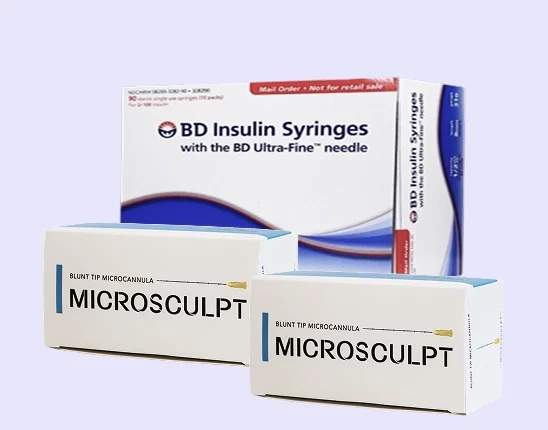The cannula is a crucial piece of equipment that no medical or aesthetic practice should ever go without. Any injector should always be familiar with the different types of cannulas available for use should the need for them arise, because their use can often determine how successful or comfortable their patient is during their procedure. More than their versatility with medical and aesthetic treatments, cannulas can also assist (and act as an alternative) in traditional needle injections.
So what are the different types of cannulas and their uses? There are three commonly deployed cannula variants in the field of medicine and cosmetology: the IV cannula, the nasal cannula, and the blunt-tip medical microcannula. A practice that offers both medical and cosmetic services should always have all three of these cannula variants on hand at all times and should be intimately knowledgeable about the best situations to use them.

Injections Your Patients Will Love! Code “20OFF” Takes 20% off Your First Order!
Microcannulas are a tool that every great injector must master. Patients want quick results with no downtime. Our microcannulas are high quality and a fraction of the price of our competitors!
You can create an account here.
The Three Different Types Of Cannulas
The cannula is a tube that’s used in the insertion of the needle, which extends its length by half or more depending on the length of the tubing. Cannula size differs depending on the procedure and the comfort levels of the patient, so an injector should always keep these considerations in mind before using any of these cannulas on a patient.
1. Intravenous Cannula
The most commonly-used cannula in medical settings is the venous cannula, which is commonly used in procedures like a cardiopulmonary bypass, cardiac surgery, and the extraction and deployment of medicines directly into the patient’s veins. By using a peripheral IV cannula, doctors and nurses can insert intravenous fluid, medication, and other compounds directly into the blood via the vein, rather than waiting for the patient to ingest them orally.
While the insertion of the IV cannula is a relatively common procedure, the injection itself does not come without the risk of complication. Problems with the tubing, the infusion, the intravenous line, and even errors in the cannulation site can occur with the insertion of different IV cannulae, so injectors must be well-trained in their use and deployment before using one.
A particular distinction needs to be made between a peripheral IV cannula and a central line IV cannula. A peripheral IV cannula is only injected in a vein located on the extremities and limbs of the body, usually for intravenous medication and extraction of blood samples. A central line IV cannula is always placed in major vein systems of the body, like the jugular vein, femoral vein, or axillary vein. Both iv catheter types can come in different sizes that can determine the overall flow rate of the medicine/blood that goes through the tube, and the attending physician should always be careful to never misjudge the cannula size required for their patient.
2. Nasal Cannula (Oral nasal cannula)
The high flow nasal cannula differs from the standard cannula used in IV treatments in its role in oxygen therapy, where the delivery of supplemental oxygen, measurement of airflow into the patient’s nose and mouth, or the delivery of medications like anesthetics is crucial to a procedure’s success. It is commonly inserted into the nostrils and mouth instead of the artery and is usually longer compared to an arterial cannula.
The efficacy of a nasal cannula isn’t measured in the fluid flow rate, but rather the speed at which it can deliver supplemental oxygen and other air-based medication into the patient’s system. For procedures like a tracheostomy, this type of catheter is critical for helping the patient receive oxygen directly to their lungs safely and efficiently. As a core component of a tracheostomy tube, practices should be extremely careful to use the right cannula size to let the most amount of oxygen in without risking the patient’s comfort.
3. Microcannula
The blunt-tip micro cannula has quickly emerged as an alternative for traditional hypodermic needle treatments, especially for procedures like the injection of dermal filler. Unlike other cannulas, the microcannula is a needle-like injection tool that can penetrate the skin via a single incision point, rather than puncturing its way through the dermal layers like a sharp-tip needle.
It does not have an inner cannula or outer cannula, as the primary use of the microcannula is to deliver filler materials (sometimes with varying fluid flow rate) to injection sites around the face and skin. They are incompatible for blood transfusion procedures or for the drawing of a blood sample despite their needle-like appearance – though microcannula liposuction techniques have steadily been rising as a less painful and more efficient way of extracting fat.
The significant advantage of the microcannula over the standard hypodermic needle is that the patient experiences less overall trauma with microcannula use compared to needles, with a reduced likelihood of developing a complication from the aesthetic treatment. As more non-invasive methods of aesthetic improvements are sought out by patients, the use of the blunt-tip cannula is fast becoming a necessity for many cosmetic and medical practices alike.
Dermatologists and doctors should always take the right precautions before the insertion of any of these cannulas into their patients, as complications from improper cannula use can range from mildly debilitating to life-threatening. If possible, consult with the manufacturers of the cannula for recommendations on their best use, and make sure that there are procedures in place to help the patient if the insertion goes wrong.
Buy Medical Cannulas And Other Supplies From FACE Medical Supply Today
-
 Microcannula Multi-Gauge Precision Set
Microcannula Multi-Gauge Precision Set -
 Microcannula Complete Injection System
Microcannula Complete Injection System -
 Microcannula Size Progression Training Kit
Microcannula Size Progression Training Kit -
 Microcannula Professional Starter Kit
Microcannula Professional Starter Kit -
 Microcannula Volume Practice Pack
Microcannula Volume Practice Pack -
 23 gauge 50 mm (2 inch) Microcannulas
23 gauge 50 mm (2 inch) Microcannulas -
 22 Gauge 100 mm (4 inch) Microcannulas.
22 Gauge 100 mm (4 inch) Microcannulas. -
 27 Gauge 38 mm (1.5 inch) Microcannulas
27 Gauge 38 mm (1.5 inch) Microcannulas -
 25 Gauge 38 mm (1.5 inch) Microcannulas
25 Gauge 38 mm (1.5 inch) Microcannulas
The proper use of a cannula is necessary for a successful medical procedure. Doctors and dermatologists should always have access to different types of medical-grade cannulas for different procedures, as a reliable supply of cannulas can ensure that their practices can continue to meet the needs of their clients.
FACE Medical Supply has extensive experience in providing medical and cosmetic practices with the equipment and tools that they need for their daily operations, at competitive prices that won’t affect their bottom line. We pride ourselves on establishing long-term relationships with our clients, helping extend their services and serve their patients better with prompt delivery of needed supplies and excellent customer service.
For more information about us and the different products and services that we can offer, contact us today.












